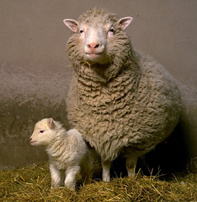Is it ethical to keep someone alive who really doesn't want to be? That seems more like an "opposite of murder" thing than duplicating people. For example, I'm sure that there are some extreme anti-suicide (assisted or not) viewpoints that could be considered unethical.
If a person is in such incurable pain as to have his/her quality of life as non existent and he/she requests that it be ended, then I'm all for assisted suicide/s.
I don't think it's wise nor ethical to ''play'' with nature, to change it for our benefit. Murdering life or ''doubling'' it really are concepts cut from the same cloth - selfishness.
I first thought of Dolly the Sheep....
http://www.animalresearch.info/en/medical-advances/timeline/cloning-dolly-the-sheep/
How Dolly was cloned
Animal cloning from an adult cell is much more difficult than from an embryonic cell. So when scientists working at the Roslin Institute in Scotland produced Dolly, the only lamb born from 277 attempts, it was a major news story around the world.
To produce Dolly, scientists used an udder cell from a six-year-old Finn Dorset white
sheep. They had to find a way to 'reprogram' the udder cells - to keep them alive but stop them growing – which they achieved by altering the growth medium (the ‘soup’ in which the cells were kept alive). Then they injected the cell into an unfertilised egg cell which had had its nucleus removed, and made the cells fuse by using electrical pulses. The unfertilised egg cell came from a Scottish Blackface ewe. When the research team had managed to fuse the nucleus from the adult white sheep cell with the egg cell from the black-faced sheep, they needed to make sure that the resulting cell would develop into an embryo. They cultured it for six or seven days to see if it divided and developed normally, before implanting it into a surrogate mother, another Scottish Blackface ewe. Dolly had a white face.
From 277 cell fusions, 29 early embryos developed and were implanted into 13 surrogate mothers. But only one pregnancy went to full term, and the 6.6 kg Finn Dorset lamb 6LLS (alias Dolly) was born after 148 days.
What happened to Dolly?

Dolly and her lamb, Bonnie© The Roslin institute
Dolly lived a pampered existence at the Roslin Institute. She mated and produced normal offspring in the normal way, showing that such cloned animals can reproduce. Born on 5 July 1996, she was euthanased on 14 February 2003, aged six and a half. Sheep can live to age 11 or 12, but Dolly suffered from
arthritis in a hind leg joint and from sheep pulmonary adenomatosis, a virus-induced lung
tumour that is common among sheep which are raised indoors.
The DNA in the nucleus is wrapped up into chromosomes, which shorten each time the cell replicates. This meant that Dolly’s chromosomes were a little shorter than those of other sheep her age and her early ageing may reflect that she was raised from the nucleus of a 6-year old sheep. Dolly was also not entirely identical to her genetic mother because the mitochondria, the power plants of the cell that are kept outside the nucleus, were inherited from Dolly’s egg donor mother.
Why clone sheep?
Dolly the sheep was produced at the Roslin Institute as part of research into producing medicines in the milk of farm animals. Researchers have managed to transfer human genes that produce useful proteins into sheep and cows, so that they can produce, for instance, the blood clotting agent factor IX to treat haemophilia or alpha-1-antitrypsin to treat
cystic fibrosis and other lung conditions. Inserting these genes into animals is a difficult and laborious process; cloning allows researchers to only do this once and clone the resulting transgenic animal to build up a breeding stock.
The development of cloning technology has led to new ways to produce medicines and is improving our understanding of development and genetics.
Since Dolly
Since 1996, when Dolly was born, other sheep have been cloned from adult cells, as have
cats,
rabbits, horses and donkeys, pigs, goats and cattle. In 2004 a mouse was cloned using a nucleus from an olfactory neuron, showing that the donor nucleus can come from a tissue of the body that does not normally divide.
Improvements in the technique have meant that the cloning of animals is becoming cheaper and more reliable. This has created a market for commercial services offering to clone pets or elite breeding livestock, but still with a $100,000 price-tag.
The advances made through cloning animals have led to a potential new therapy to prevent mitochondrial diseases in humans being passed from mother to child. About 1 in 6000 people is born with faulty mitochondria, which can result in diseases like
muscular dystrophy. To prevent this, genetic material from the embryo is extracted and placed in an egg cell donated by another woman, which contains functioning mitochondria. This is the same process as used in cloning of embryonic cells of animals. Without this intervention, the faulty mitochondria are certain to pass on to the next generation.
The treatment is currently not permitted for use in humans. However, the Human Fertilisation & Embryology Authority in the UK has reported that there is general support in the public for legalising the therapy and making it available to patients.
Read about more breakthrough advances in science made through animal research in our timeline
